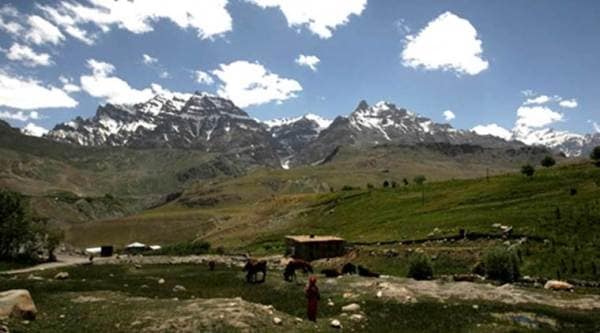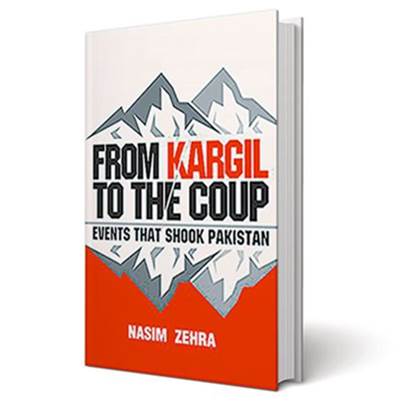Fire in the Mountains
An analysis of Pakistan’s disastrous Kargil campaign and how it unravelled, yet again, India and Pakistan’s tenuous relationship

A view of the Drass Valley with Tiger Hill in the background. In the run-up to the Kargil War, members of the Pakistani army infiltrated into Indian territory from Tiger Hill. (Express Photo/Tashi Tobgyal)
Title: From Kargil to the Coup: Events that Shook Pakistan
Author: Nasim Zehra
Publisher: Sang-e-Meel Publications
Pages: 532
Price: PKR 1,500
Author: Nasim Zehra
Publisher: Sang-e-Meel Publications
Pages: 532
Price: PKR 1,500
Nasim Zehra’s From Kargil to the Coup: Events That Shook Pakistan is riveting. She succeeds in capturing almost all aspects of Pakistan’s disastrous Kargil military misadventure, but from her country’s standpoint. In doing so, Zehra illuminates the motivations, assumptions, objectives, vanities and follies of the “Kargil clique” which set it in motion. It consisted of Pakistan’s army chief General Pervez Musharraf, chief of general staff Lieutenant General Aziz Khan, commander of the 10th corp, Lieutenant General Mahmud Ahmed and the force commander, Northern Areas, Major General Javed Hasan. Zehra also focuses on prime minister Nawaz Sharif’s different approaches during this entire sorry period. She falters, though, in her account and assessments of the Indian response, its underlying thinking and consequent strategy.
Not surprisingly, though inaccurately, Zehra places the motivations of the Kargil clique in the historical context of Jammu and Kashmir, and, more specifically, the Siachen issue. Her argument that the absence of a political route in resolving the J&K issue injected the “use of force” in the DNA of India-Pakistan relations, is a half-truth; India has not resorted to force except reactively and reluctantly, but Pakistan has, and continues to do so, through its use of terror. It was the nuclear factor, as Zehra correctly notes, an attempt to exploit the nuclear card, that led to the clique’s misplaced assurance that the international community would quickly move in to compel a ceasefire which would allow Pakistan to retain the Kargil heights and threaten India’s northern defences. The leadership also thought that the Indian army lacked the stomach to take losses; hence, India would settle for peace on Pakistan’s terms. Zehra should have examined if this is the result of deeply ingrained but bizarre prejudice against India and Hindus. Can such an army be trusted with control over nuclear weapons?

The nuclear tests of May 1998 imparted an urgency to finalise the composite dialogue structure. Contrary to what Zehra suggests, India was not delaying the process. It wanted a structure to the talks that would be not be used by Pakistan for purely propagandist purposes on the J&K issue. Once that was assured, the structure was finalised. Indian Prime Minister Atal Bihari Vajpayee and Sharif approved it in September 1998 in New York and meetings were held in Islamabad and Delhi. Sharif’s appointment of Musharraf as army chief after Jehangir Karamat resigned coincided with the beginning of the dialogue and he informally approved the Kargil operation almost immediately thereafter. Thus, while the elected and constitutional government pursued the path of diplomacy with India which led to Vajpayee’s Lahore visit, the Pakistan army launched an unauthorised, and, therefore, rogue operation.
In fascinating detail, Zehra traces the phases of Pakistan’s Kargil operation. She appropriately notes that there were six phases: euphoria, excitement, expansion, encounter, exit and effect. It is incredible that in an army which values its professionalism, a clique led by the chief should have undertaken a major surreptitious operation in the territory normally controlled by a neighbouring state, with which relations have been hostile, without a full systemic analysis. It was three months after the operation was launched that Musharraf formally approved it. Indeed, once the full scope of the Pakistani operation became known, India’s military and diplomatic strategists initially could not believe that the Pakistan army would not have anticipated a full Indian response to evict it from posts that threatened the lifeline of its northern defences. What was their game plan once that happened? That was the initial question. And then it became blindingly clear that there was none. Can there be anything except contempt for such amateurish thinking, whatever gloss Musharraf may continue to put on it?
Sharif learnt about the details of the Kargil operation on May 17 and 18. His vanity was tickled when CGS Lieutenant General Aziz Khan told him that he would be remembered as Fatah-e-Kashmir. At that stage, had he called off the operation the army may well have fatally wounded him politically but it is more likely that he thought that Kashmir was in the bag — till the fierce Indian response began. Many of his ministers, among whom were retired generals, harboured no such illusions. They realised that Pakistan had made a monumental mistake.
In India, the overall policy to evict Pakistan from Kargil was fashioned by Vajpayee, external affairs minister Jaswant Singh and national security advisor Brajesh Mishra. Not once did they or the cabinet committee on security harbour any doubt that Pakistan would have to be pushed across the LOC. They brought to bear all elements of military and diplomatic power to achieve this objective while signalling that unlike Pakistan, India was a responsible nuclear power. Pakistan and the world had to be shown that the army was committed to the military task whatever the cost — and the army and the air force delivered well. The diplomatic task was to conclusively show that the Pakistani army had violated the LOC. The Kargil tapes — and Zehra is wrong to speculate about their origins — made a powerful international impact. The back and diplomatic channels messages were identical — Pakistan would have to vacate Kargil. Additionally, the back channel was also used to convey to Sharif that his army had created a mess for him. He could have come to Delhi but chose the Washington route to get out of the Kargil mess.
India briefed the Americans and conveyed that they should pressure Pakistan. This cannot be construed as seeking mediation, as Zehra suggests. Throughout this period, India relentlessly pursued its objective of throwing Pakistan back. Not once did it modify any aspect of this aim because of any suggestion that may have come from any quarter. All in all, once the surprise of Kargil was absorbed, India acted clinically and professionally and the political leadership displayed outstanding statesmanship.
The Kargil failure left Pakistan in disarray, with Sharif and Musharraf squaring off. It was inevitable that only one would remain. Brilliantly, Zehra goes in depth about all the developments that led to the coup. If the Kargil clique had executed a rogue operation, now, Sharif sought to remove Musharraf in a ham-handed, almost clandestine operation. Perhaps, he could not act openly immediately after Kargil because he was complicit with the army for a brief period and the Pakistan people had been completely misled.
Ultimately, Kargil showed the Pakistani army to be irresponsible. Has that position really changed?
The writer was Joint Secretary (Iran, Pakistan, Afghanistan) during the Kargil conflict
For all the latest Lifestyle News, download Indian Express App






















No hay comentarios:
Publicar un comentario